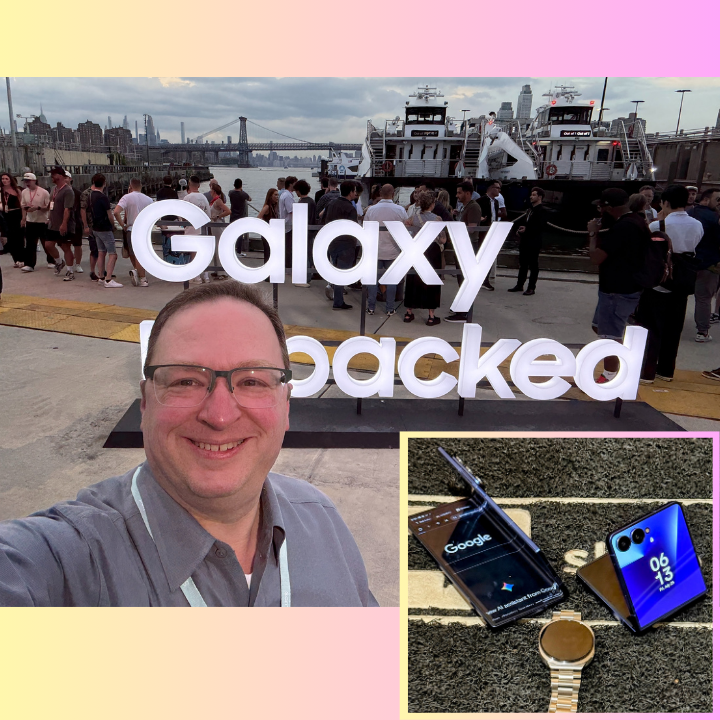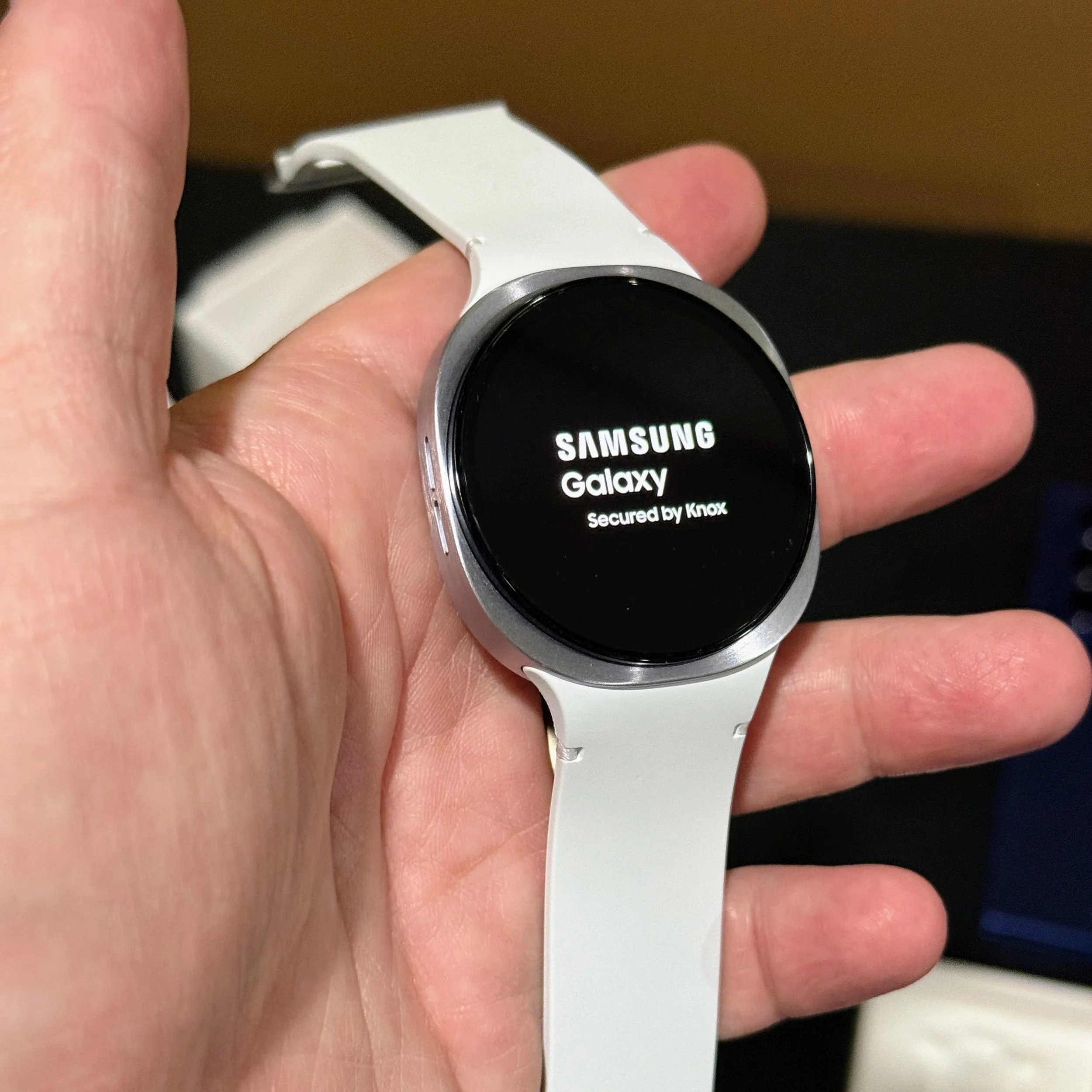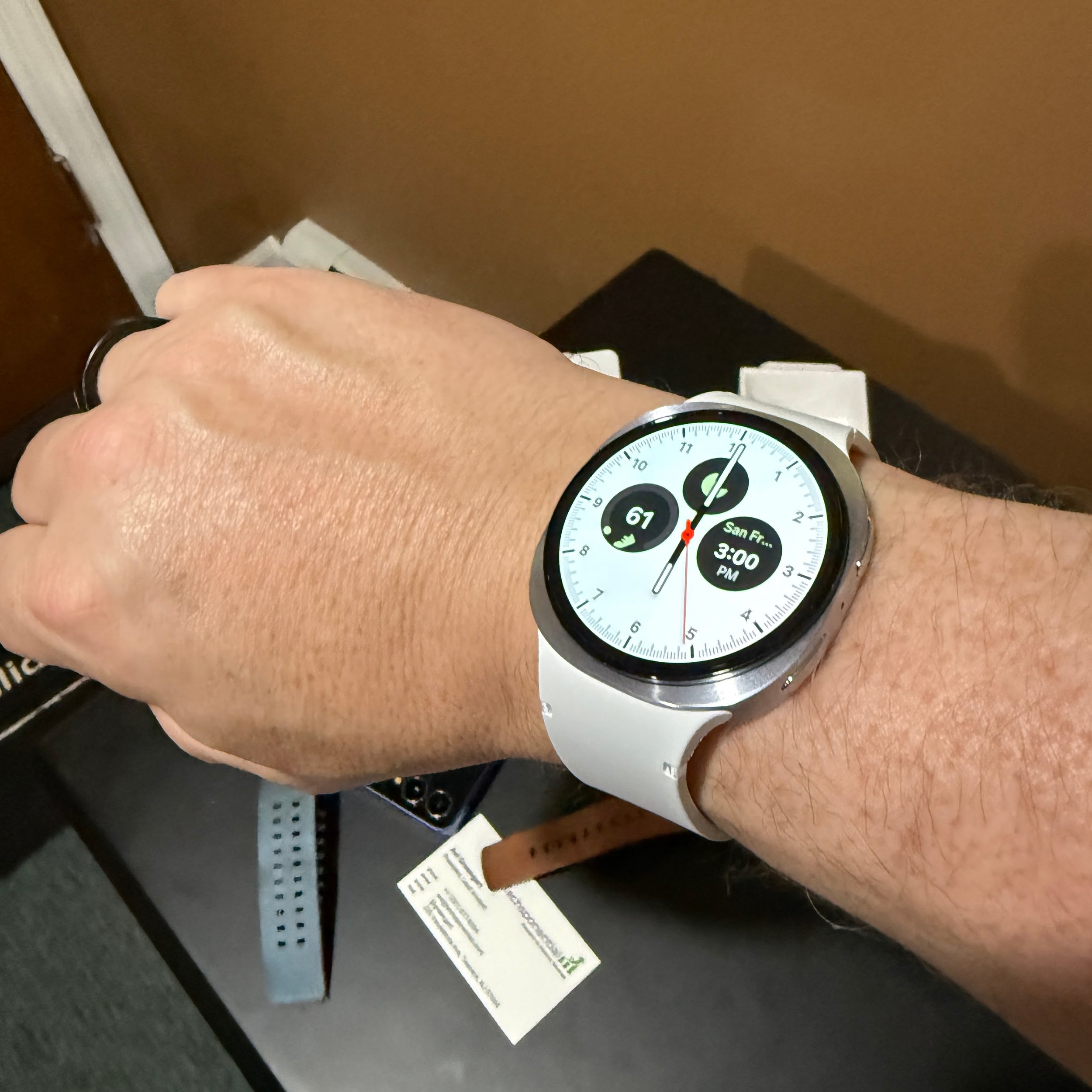Samsung Reinvents Its Foldables
Summary
This very long report could be a really short: I’ve been testing Samsung’s new foldables and wearables and they are terrific. If Samsung can get more consumers to experience the Galaxy Fold7 in person, it will grow the foldable niche despite a high price point. Early sales results are strong.
Slightly Longer Summary:
I have been testing Samsung’s new foldables and wearables since Galaxy Unpacked and they are terrific. Samsung upgraded the Galaxy Z Flip7 in small but meaningful ways at the same price as before ($1099). The Galaxy Z Fold7 has been so dramatically improved that it essentially reinvents the category and once they see it, it should get consumers considering one for the first time. It’s expensive ($2,000), but it has to be, and in the U.S., carriers are essentially selling it half off and financing the rest at 0% APR. Early sales results are strong.
The Galaxy Watch8 is thinner, lighter, and lasts longer with an exceptionally refined minimalist design. The Classic version is back for those who want a physical interface ring. Samsung is also investing in platforms that connect the data from its wearables to health care systems. The only miss from summer Unpacked is the Galaxy Flip7 FE. To broaden the base for foldables, Samsung launched a Galaxy Flip7 FE at $900; it's cheaper, but still not competitive with Motorola’s $700 (or less) razr 2025.
A New Era for Samsung Foldables
Samsung has been making foldables longer than anyone, but its product development apparently stagnated recently while competitors leapt ahead. Samsung says that it was taking the time to build up its materials design and supply chain to enable it to build foldables that are thin, light, AND durable. One preview of Samsung’s focus on thinner flagship-worthy foldables was the recent Galaxy S25 Edge, which is a bar phone, but noticeably thinner than other high-performance phones and feels impressively solid and premium in the hand.
In a conversation with a few analysts ahead of Unpacked, Samsung Electronics President TM Roh told us that he thinks of the Galaxy Z Fold generations 1 – 6 as one era, and the Galaxy Fold7 as the beginning of a new one. He’s not wrong: foldables make up less than 2% of global phone sales, and most consumers still haven’t considered the category. Unless you’re a tech enthusiast in China, you likely have never seen a device as thin as the Galaxy Z Fold7, and even if you have, the Galaxy Z Fold7’s build quality and software experience are unmatched.
Galaxy Z Fold7
I have been testing Samsung’s new foldables and wearables since Galaxy Unpacked and they are terrific.
The Galaxy Z Fold7 is a worthy flagship for Samsung. It's so thin that it looks and feels like a regular high-end phone that just happens to split open somehow and turn into an 8” tablet. After multiple variations of tall-and-thin aspect ratios, the front screen on the Galaxy Z Fold7 is now the same dimensions as a bar phone. Despite the additional components, it's lighter than a Galaxy S25 Ultra and feels rigid and dense in the hand. It can be a bit slippery when prying it open, and it wobbles terribly when placed on a table, but those are really the only complaints. It's made of new materials, with a new hinge and teardrop fold for the inner display that doesn’t show much of a crease and adds to durability: I've already accidentally drop-tested my review unit on concrete – and it didn’t get a scratch.
Samsung further minimized the compromises of a foldable by giving the Galaxy Z Fold7 the same flagship Snapdragon 8 Elite for Galaxy chipset that has huge performance gains on the CPU, GPU, and NPU while extending battery life. In my testing, the Galaxy Z Fold7’s performance was slightly lower than some other reviewers, but still performed much like a non-Galaxy edition Snapdragon 8 Elite. Without the larger and thicker heat dissipation system of a Galaxy S25 Ultra, it is still able to perform like a proper flagship phone for gaming, but can’t quite match its Ultra sibling. Samsung also couldn’t squeeze in a periscope telephoto array without creating an even bigger camera island like some Chinese competitors do, but the main camera array features the same 200 MP main camera from Samsung’s bar phones. At this level, image processing almost comes down to personal taste; I tend to like Samsung’s take on color saturation and contrast, and the Galaxy Z Fold7 acts a lot like Samsung’s other flagship phones in that regard. Samsung did not lose battery capacity as it slimmed down – it’s still 4400mAh. This is an area where moving to silicon carbon batteries would have had outsized impact, but Samsung (and Apple) is cautious in this regard. Thanks to more efficient silicon, battery life is slightly better on the Galaxy Z Fold7 than on its predecessor but it’s still just a single light day phone. Heavy days will require a recharge towards the evening. Unfortunately, charging remains slow (maximum 25W) compared to Chinese rivals. The 15W wireless charging lacks Qi2 magnets, but that can be excused on thinness grounds. Also ditched to save on height: the digitizing layer that enabled a Fold-specific S Pen. The S Pen was always an extra purchase and Samsung says few used it. This is a loss, but a reasonable decision. The one thing that actually got thicker? The layer of ultra-thin glass, which sits above and below layers of plastic but makes the display feel more rigid to the touch.
Software (and AI, Because Of Course)
Samsung’s new One UI 8 software sits on top of the latest version of Android (16) and is well integrated with AI functionality from both Samsung and Google. Jisun Park, Corporate Executive Vice President and Head of Language AI Team, Mobile eXperience (MX) Business at Samsung Electronics, said that since the launch of the Galaxy S25 series in January, more than 70% of users have engaged with Galaxy AI features. Samsung’s integration of Google Gemini has resulted in genuinely useful capabilities beyond creating emoji. The additional screen real estate on the inner Galaxy Z Fold7 display makes these use cases even more compelling. For example, the other day I had Gemini translate a page of foreign language social media posts, even though each post was an image – all without leaving the app. Apple can’t do any of this.
Much of the promise of agentic AI on your phone is still unrealized, but if you live in Google and Samsung apps you can get a flavor of that future today by asking Gemini to take limited actions that integrate with your calendar or Notes. There are a handful of other apps that play along, including Spotify. However, broader interoperability with Microsoft and the rest of the mobile app ecosystem remains a promise for the future.
Apple promotes security and privacy heavily in its ads, and Google has been making significant improvements to Android for spam, scam, and theft control. While it doesn’t get much play in the press, Samsung has a really good story to tell around its Knox security suite. Knox has long added unique security on top of Android for things like private storage for consumers, and mobile authentication and management for enterprises. At Unpacked, Samsung announced KEEP (Knox Enhanced Encrypted Protection) that locks down apps from seeing each other’s data. This works in the background for all Android apps running on the Galaxy Z Fold7 and Flip7. It will be coming to other Samsung phones with a software update, and it needs to get more attention because it cuts off a serious privacy and security intrusion vector.
Value Proposition of a Phone That Somehow Splits Open
Samsung heavily promotes the productivity benefits of the tablet form factor, and that is understandable. My most common use case is simple: seeing email and calendar at the same time (Microsoft really needs to create a standard layout for this within Outlook). However, whenever I showed the Galaxy Z Fold7 to someone over forty, they immediately asked if the large interior screen means that you can bump up the font size and still have a lot of information on the screen. Yes. This is a terrific use case for a fold-larger phone. Not all phone buyers – especially for $2,000 phones – are in their twenties. Samsung also needs to highlight the entertainment benefits of the additional real estate beyond just gaming, which got a blink-and-you-missed-it slot during the Unpacked keynote. You can watch YouTube full-sized and see the comments. You can watch Netflix while texting with a friend who is also watching the show. The book form factor is fantastic for scrolling through nested Reddit forums, or reading actual books and graphic novels in vibrant color in the Kindle app.
The obvious concern with a phone that’s priced this high is that the price is too high, but there really wasn’t much of an alternative. It costs a lot to build a device this sophisticated, and Samsung has learned that once consumers are investing at this level, they would far prefer a $100 increase to get the best cameras, displays, processors, and durability rather than a $100 decrease for less content. The result of this thin, light, and ‘regular phone’ form factor is that when regular consumers see it unfold, they react like it’s a magic trick. I have now had the Galaxy Z Fold7 for several weeks, and the delight of opening up a “normal” phone into a tablet has not faded.
Galaxy Flip7
If the fold-out Galaxy Z Fold7 is a productivity and size magic trick, the fold-smaller Galaxy Z Flip7 is more accessible fun and fashionable. While Samsung hasn’t gone full Motorola in terms of CMF (Colors, Materials, and Finishes), the Galaxy Z Flip7 is available in actual colors, including a deep Blue Shadow, light green Mint, and nicely saturated Coralred. (The Galaxy Z Fold7 is also available in Blue Shadow; it’s the one to get.) Samsung continues to promote the Flip line as a regular phone that folds for main-camera selfies, self-standing selfies, and fitting in smaller pockets and handbags. Samsung made many of the same improvements to the Galaxy Z Flip7 as its bigger Z sibling: the teardrop hinge, improved durability, thinned-down chassis, and even a wider exterior aspect ratio that leads to a larger interior display.
The Galaxy Z Flip7’s exterior display now extends almost completely edge-to-edge with cutouts for the cameras rather than appearing as an asymmetrical window across most of the front. Motorola kicked off the camera cutout design with the razr+ in 2023, and it definitely adds to the coolness factor even if it doesn’t actually increase usable screen real estate much. Samsung has added more widgets and flexibility to take advantage of the front screen of the Galaxy Z Flip7, but Samsung still makes it difficult to run full apps on the front display without jumping through hoops. I frequently run Microsoft To Do on the Moto razr’s exterior display for checking off tasks and accessing shopping lists, and having Outlook on the front screen means I can see my full schedule without having to open the phone. Motorola is also more flexible with designating how apps behave when you are running them on either display and then switch. This remains a key weakness to Samsung’s fold-smaller experience.
However, unlike the Galaxy Z Fold7, where cost is secondary to performance and capability, with the fun-first Galaxy Z Flip7, Samsung knew that it needed to keep pricing stable. To keep from rising above last year’s $1,100 price point, Samsung is a bit less “ultra,” downgrading the cameras to a pair of 50 MP wide and 12 MP ultrawide arrays that match the Galaxy S25, not the Galaxy S25 Ultra. These perform well, though I do wish Samsung had somehow managed to include a telephoto camera, something social media obsessed Galaxy Z Flip7 owners will actually miss. The front hole-punch selfie camera is 10 MP, but users can always use the exterior display and main 50 MP camera instead. The processor also gets a bit of a downgrade, to a Samsung Exynos 2500 that performs similarly to last year’s Snapdragon 8 Gen 3 in my testing. This is fine; the target consumer of the Galaxy Z Flip7 is not running Geekbench, and few mobile apps stress processors enough for users to notice the difference. The new processor appears to be efficient, and the Galaxy Z Flip7 gained a bit of battery size over last year’s model: Samsung claims an additional 2+ hours of use over the Galaxy Z Flip6. In my testing, it was clearly better, but still no endurance champ. You should be able to make it through the day on all light and most moderate workloads.
The Galaxy Z Flip7 runs the same software as the Galaxy Z Fold7, and gets the same seven years of support. It also gets DeX for the first time, which will make tech enthusiasts happy, even if few people actually use the desktop windowing system. Overall, Samsung upgraded the Galaxy Z Flip7 in multiple iterative but meaningful ways and cut costs by using an in-house processor that won’t put Qualcomm out of business but performs well enough for this product’s intended use. That’s a win.
Galaxy Watch8
The Galaxy Z Fold7 has been so dramatically improved that it essentially reinvents the category and should get consumers considering one for the first time. The Galaxy Watch8 is more of a typical annual interative improvement, but I like it more than any Galaxy Watch in recent memory. The Galaxy Watch8 is thinner, lighter, and lasts longer on battery (though you’ll still need to recharge daily). The exceptionally refined minimalist design shape-shifts based on what type of band you use with it. Samsung also brought back a Watch8 Classic version for those who want a physical interface ring. The ring bezel makes the watch thicker, but also imparts a more premium look, and Samsung’s UI overlay on top of Google WearOS 6.0 has always been optimized for navigation with what is essentially a rotating scroll wheel.
Like all watch and fitness vendors these days, Samsung is introducing a host of AI-powered features and coaching. In addition to fitness, health, and “vascular load,” Samsung’s newest sensor can test antioxidant levels by assessing beta carotene skin tone. I’m not sure if this information is accurate, or what to do with it if it is.
Samsung is also investing in platforms that connect the data from its wearables to health care systems. It recently acquired Xealth, a digital health platform with a network of more than 500 hospitals and 70 digital health solution providers. Through Xealth, Samsung plans to connect wearable data and insights from Samsung Health into clinical workflows — delivering a more unified and seamless healthcare experience. That’s obviously a vision that will take tremendous execution to realize, but it demonstrates Samsung’s ambitions in digital health beyond strapping sensors to your wrist.
What Samsung Didn’t Show Off
Despite planning to ship both a upcoming trifold smartphone/tablet and a AndroidXR VR headset (aka Project Moohan) later this year, Samsung deliberately did not talk about them at Unpacked. This was smart. The Galaxy Z Fold7 is expensive, but it really can make sense for well-heeled mainstream consumers. The trifold is likely to be a limited-edition $3,500+ halo product that would have stolen attention and sales from the Galaxy Z Fold7. When it is released later this year it will serve mostly as a way for Samsung to gain experience with the form factor ahead of Apple entering folding phones, expected in 2026 or 2027.
The VR headset would have been a distraction as well, mostly because it is aimed at completely different use cases. Samsung does need to start a concerted developer effort with Google and create clear positioning ahead of launch or Project Moohan will suffer the same confusion of purpose as the Apple Vision Pro.
Competition
In the fold-larger space, Samsung is competing with Google’s Pixel Pro Fold, which is due to be upgraded in the coming month. Few of the nearly-as-thin Chinese foldables are sold in Samsung’s primary markets, and none have its software and security stack. Apple is rumored to be entering foldables in 2026 or 2027. The Galaxy Z Fold8 or 9 should be out by then; Samsung is prepared.
In the fold-smaller category, Samsung is seeing extensive competition from Motorola’s razr family. The Moto razr ultra has a faster Snapdragon 8 Elite processor, a more usable exterior display experience, and more exciting materials – my review unit has a rear panel made of real wood – but all that comes at a significantly higher $1,500 price point. The $1,000 Moto razr+ is closer competition to the $1,100 Galaxy Z Flip7. Motorola undercuts Samsung on price – especially since the razr+ is currently on sale at motorola.com for $850 – but loses out in durability and performance, especially of its cameras.
Where Motorola (and silicon supplier MediaTek) is really seeing sales volumes is with its $700 base model razr, currently on sale online for $500. It also sells for $600 postpaid at Verizon, and for as little as $400 at some U.S. prepaid carriers. To broaden its addressable base for foldables, Samsung launched a Galaxy Flip7 FE that runs last year’s Exynos 2400 and has a design that is nearly identical to the Galaxy Z Flip6. It, too, gets the latest Galaxy One 8 UI and Android 16 software. Unfortunately, at $900, the Galaxy Flip7 FE is not even close to cost competitive with Motorola’s base model razr 2025. Samsung should have leaned into the premium products alone now, and launched the FE at a lower price point at a later date.
Early Sales Results
Early presales and launch numbers are in, and both the Galaxy Z Fold7 and Galaxy Z Flip7 are selling well. How well? Samsung provided a series of Bezos numbers (i.e., comparisons without baselines):
Galaxy Z Fold7 received the most preorders in Z Fold history in the U.S.
Both Galaxy Z Fold7 and Galaxy Z Flip7 combined saw more than a 25% increase in preorders compared to the previous generation.
Carriers saw a nearly 60% pre-order cumulative jump for both devices compared to last year’s models. This was greatly helped by every carrier running promotions which effectively knocked $1,000 off with trade-in and then 0% financing over 24 – 36 months for the remainder.
Since general availability, momentum for both devices remains strong, with orders continuing to outpace the previous generation by more than 25%. In particular, Galaxy Z Fold7 is outpacing its previous model by nearly 50% since availability opened on July 25.
While actual sales numbers would have been preferable, it is clear that Samsung’s new generation of foldables is off to a good start. Samsung also provided some color about, well, color. Blue Shadow received nearly half of all preorders for Z Fold7, and Coralred exceeded expectations, making up nearly 25% of preorders of Flip7. Both of these trends remain steady through the first week of availability.
Samsung did not provide any information on Galaxy Watch8 sales comparisons.
For Techsponential clients, a report is a springboard to personalized discussions and strategic advice. To discuss the implications of this report on your business, product, or investment strategies, contact Techsponential at avi@techsponential.com.



























